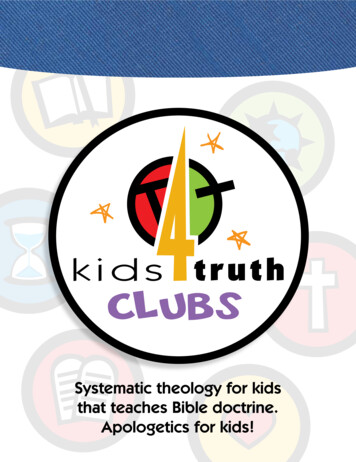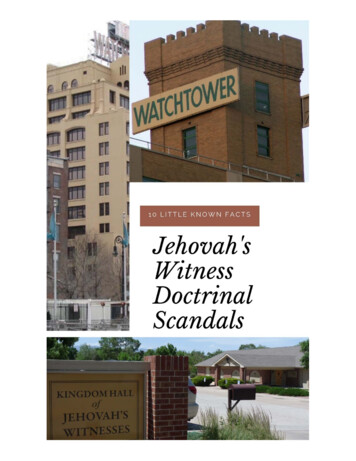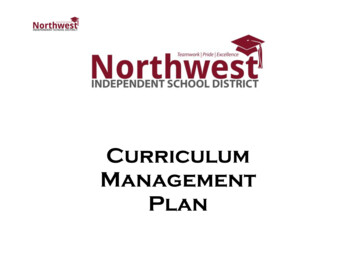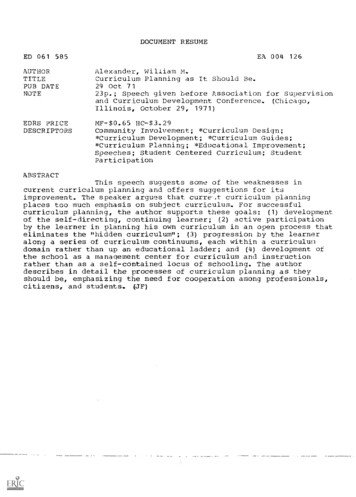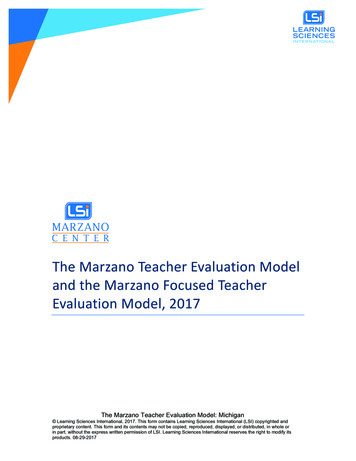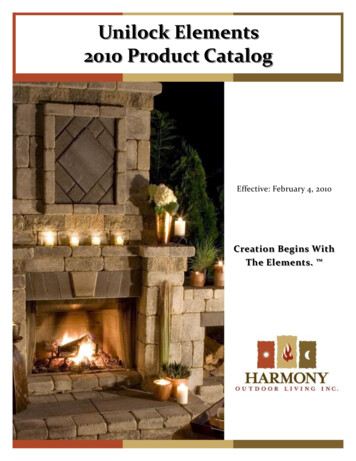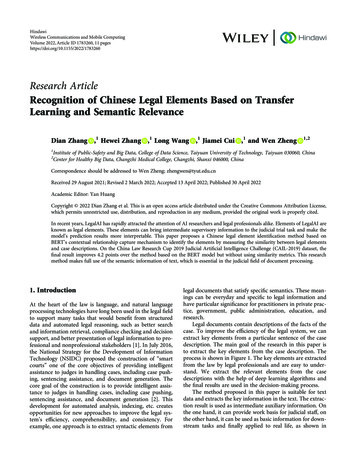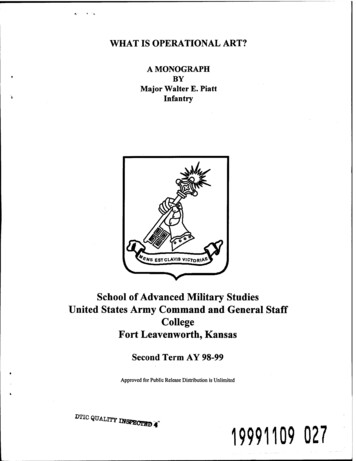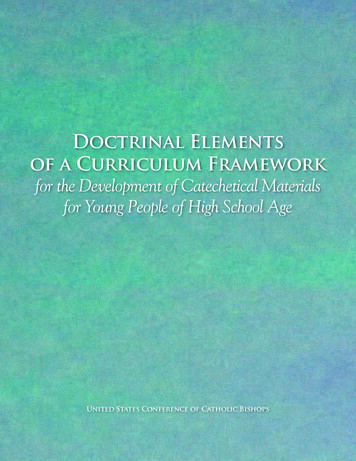
Transcription
Doctrinal Elementsof a Curriculum Frameworkfor the Development of Catechetical Materialsfor Young People of High School AgeUnited States Conference of Catholic Bishops
Doctrinal Elements of a Curriculum Frameworkfor the Development of Catechetical Materialsfor Young People of High School AgeUnited States Conference of Catholic Bishops Washington, D.C.Doctrinal Elements of a Curriculum Framework for theDevelopment of Catechetical Materials for Young People of High School Agei
The document Doctrinal Elements of a Curriculum Framework for the Development of Catechetical Materials for YoungPeople of High School Age was developed by the Committee on Evangelization and Catechesis of the United StatesConference of Catholic Bishops (USCCB). It was approved by the full body of the USCCB at its November 2007General Meeting and has been authorized for publication by the undersigned.Msgr. David J. Malloy, STDGeneral Secretary, USCCBExcerpts from the Catechism of the Catholic Church, second edition, copyright 2000, Libreria Editrice Vaticana–United States Conference of Catholic Bishops, Washington, D.C. Used with permission. All rights reserved.Scripture texts used in this work are taken from the New American Bible, copyright 1991, 1986, and 1970 by theConfraternity of Christian Doctrine, Washington, DC 20017 and are used by permission of the copyright owner.All rights reserved.Excerpts from Vatican Council II: The Conciliar and Post Conciliar Documents edited by Austin Flannery, OP,copyright 1975, Costello Publishing Company, Inc., Northport, N.Y., are used with permission of the publisher,all rights reserved. No part of these excerpts may be reproduced, stored in a retrieval system, or transmitted in anyform or by any means—electronic, mechanical, photocopying, recording, or otherwise—without express writtenpermission of Costello Publishing Company.ISBN: 978-1-60137-042-6First printing, July 2008Copyright 2008, United States Conference of Catholic Bishops, Washington, D.C. All rights reserved. No partof this work may be reproduced or transmitted in any form or by any means, electronic or mechanical, includingphotocopying, recording, or by any information storage and retrieval system, without permission in writing fromthe copyright holder.
ContentsAbbreviations . . . . . . . . . . . . . . . . . . . . . . . . . . . . . . . . . . . . . . . . . . . . . . . . . . . . . . . . . . . ivIntroduction . . . . . . . . . . . . . . . . . . . . . . . . . . . . . . . . . . . . . . . . . . . . . . . . . . . . . . . . . . . . 1Core Curriculum . . . . . . . . . . . . . . . . . . . . . . . . . . . . . . . . . . . . . . . . . . . . . . . . . . . . . . . . 2I. The Revelation of Jesus Christ in Scripture . . . . . . . . . . . . . . . . . . . . . . . . . . . . . . . . . . . . 2II. Who Is Jesus Christ? . . . . . . . . . . . . . . . . . . . . . . . . . . . . . . . . . . . . . . . . . . . . . . . . . . . . . . 6III. The Mission of Jesus Christ (The Paschal Mystery) . . . . . . . . . . . . . . . . . . . . . . . . . . . 11IV. Jesus Christ’s Mission Continues in the Church . . . . . . . . . . . . . . . . . . . . . . . . . . . . . . 15V. Sacraments as Privileged Encounters with Jesus Christ . . . . . . . . . . . . . . . . . . . . . . . . . 20VI. Life in Jesus Christ . . . . . . . . . . . . . . . . . . . . . . . . . . . . . . . . . . . . . . . . . . . . . . . . . . . . . 27Electives . . . . . . . . . . . . . . . . . . . . . . . . . . . . . . . . . . . . . . . . . . . . . . . . . . . . . . . . . . . . . . . . . 31Option A. Sacred Scripture . . . . . . . . . . . . . . . . . . . . . . . . . . . . . . . . . . . . . . . . . . . . . . . . . . 31Option B. History of the Catholic Church . . . . . . . . . . . . . . . . . . . . . . . . . . . . . . . . . . . . . .35Option C. Living as a Disciple of Jesus Christ in Society . . . . . . . . . . . . . . . . . . . . . . . . . . 40Option D. Responding to the Call of Jesus Christ . . . . . . . . . . . . . . . . . . . . . . . . . . . . . . . . 44Option E. Ecumenical and Interreligious Issues . . . . . . . . . . . . . . . . . . . . . . . . . . . . . . . . . . 49
AbbreviationsCCCCatechism of the Catholic Church (2nd ed.). Washington, DC: Libreria Editrice Vaticana–United States Conference of Catholic Bishops, 2000.CICCode of Canon Law: Latin-English Edition: New English Translation (Codex Iuris Canonici).Washington, DC: Canon Law Society of America, 1998.CTPope John Paul II. On Catechesis in Our Time (Catechesi Tradendae). Washington, DC:United States Conference of Catholic Bishops, 1987.DVVatican Council II. Dogmatic Constitution on Divine Revelation (Dei Verbum).FCPope John Paul II. On the Family (Familiaris Consortio).GDCCongregation for the Clergy. General Directory for Catechesis. Washington, DC: UnitedStates Conference of Catholic Bishops, 1998.LGVatican Council II. Dogmatic Constitution on the Church (Lumen Gentium). In VaticanCouncil II: Volume 1: The Conciliar and Post Conciliar Documents, edited by AustinFlannery. Northport, NY: Costello Publishing, 1996.NABNew American Bible.NDCUnited States Conference of Catholic Bishops. National Directory for Catechesis.Washington, DC: United States Conference of Catholic Bishops, 2005.OSPope John Paul II. On Reserving Priestly Ordination to Men Alone (Ordinatio Sacerdotalis).Washington, DC: United States Conference of Catholic Bishops, 1994.RCIARite of Christian Initiation for Adults.URVatican Council II. Decree on Ecumenism (Unitatis Redintegratio).USCCA United States Conference of Catholic Bishops. United States Catholic Catechism forAdults. Washington, DC: United States Conference of Catholic Bishops, 2006.ivDoctrinal Elements of a Curriculum Framework for theDevelopment of Catechetical Materials for Young People of High School Age
IntroductionI have told you this so that my joy may be in you and your joy may be complete. (Jn 15:11)“The definitive aim of catechesis is to put peoplenot only in touch but in communion, inintimacy, with Jesus Christ” (CT, no. 5). Theseends are evident in this framework—designed to guidecatechetical instruction for young people of high-schoolage wherever and however it takes place: in Catholic highschools, in parish religious education programs, with youngpeople schooled at home, or within the context of thecatechetical instruction which should be part of every youthministry program. The Christological centrality of thisframework is designed to form the content of instructionas well as to be a vehicle for growth in one’s relationshipwith the Lord so that each may come to know him andlive according to the truth he has given to us. In this way,disciples not only participate more deeply in the life of theChurch but are also better able to reach eternal life withGod in Heaven.As a framework, this document offers guidance tocatechetical publishers in the creation of instructionalmaterial. Within each theme, doctrinal elements related toit are identified. The order in which the doctrinal elementswithin each theme are identified should not be understoodto be an outline of a text or course. Rather, they are offeredas building blocks that can be combined in any number ofways within that particular thematic structure and can beaugmented with additional doctrinal teaching, dependingon the creativity of authors and editors. In addition toaiding those creating catechetical texts and materials,this framework will also serve to aid those responsiblefor overseeing catechetical instruction within dioceses aswell as those responsible for curriculum development orthe development of assessment instruments designed tocomplement texts, programs, or curriculums. It is understoodthat implementation of a new curriculum will require timefor the development of new materials as well as revisionto diocesan guidelines and curricular structures withinschools and religious education programs. A successfulimplementation will rely heavily on catechetical publishersof high-school-age materials as well as on the teachers andcatechists of high-school-age young people.The framework is designed to shape a four-year, eightsemester course of catechetical instruction. It is composedof six core semester-length subject themes with room for adiocese or school to choose two elective subject themes. Itis strongly recommended that the core courses be coveredin the order in which they appear in this framework. Thesequence in which the core curriculum appears reflects asystematic point of view in which each course builds on afoundation laid by those that precede it. In addition, somenational uniformity in catechetical instruction on the highschool-age level would be a benefit in the modern mobilesociety. Five possible elective themes appear as part of thisframework. Normally, the elective themes should appeareither as one in the third year and one in the fourth year orboth in the fourth year.Since this is a framework and not a tool for directinstruction, the doctrines and topics designated are notnecessarily defined or completely developed. Such detail willbe present in the catechetical texts and materials that willbe developed on the basis of this framework. It is expectedthat after developing new materials, publishing houses willsubmit them for a review as to their conformity with theCatechism of the Catholic Church. The process of that reviewwill ensure that the materials authentically and completelydefine and present the teaching of the Church.In addition to providing guidance about the doctrinalcontent of catechetical instruction for high-school-ageyoung people, this framework is also designed to help thosesame young people develop the necessary skills to answer oraddress the real questions that they face in life and in theirCatholic faith. Within each theme, including the electives,there is a section titled “Challenges,” which raises examplesof these questions and provides direction for ways toanswer them. This element is designed to give catecheticalinstruction for high-school-age young people an apologeticalcomponent. Publishers and teachers or catechists are tostrive to provide for a catechetical instruction and formationthat is imbued with an apologetical approach. Challengesthat appear under one particular theme can also apply toother themes in the framework, and such application isencouraged. The identification and inclusion of additionalchallenges by publishers and by teachers or catechists toachieve this goal is also encouraged.Doctrinal Elements of a Curriculum Framework for theDevelopment of Catechetical Materials for Young People of High School Age1
Core CurriculumI. The Revelation of Jesus Christ in ScriptureThe purpose of this course is to give students a general knowledge and appreciation of the Sacred Scriptures. Through their studyof the Bible they will come to encounter the living Word of God, Jesus Christ. In the course they will learn about the Bible,authored by God through Inspiration, and its value to people throughout the world. If they have not been taught this earlier,they will learn how to read the Bible and will become familiar with the major sections of the Bible and the books included in eachsection. The students will pay particular attention to the Gospels, where they may grow to know and love Jesus Christ more personally.I.How Do We Know About God?A. The thirst and desire for God (Catechism of the CatholicChurch [CCC], nos. 27-30, 44-45, 1718).1. Within all people there is a longing for God.2. That longing itself is from God, who desires andinitiates a relationship with each person.3. Only in God can lasting joy and peace be found inthis life and in the next.B. God revealed in many ways.1. Natural Revelation (CCC, nos. 32-34).a. Natural Revelation attested to in SacredScripture (CCC, no. 32).1) Old Testament references, includingGenesis and Wisdom.2) Paul’s Letter to the Romans.b. Patristic testimony (CCC, no. 32).c. Scholastic theology’s arguments for theexistence of God (CCC, nos. 31, 34).1) St. Thomas Aquinas and the five proofsfor the existence of God.d. Vatican I: we can grasp with certainty theexistence of God through human reason(CCC, nos. 36-38, 46-47).e. Contemporary arguments based on the humanperson’s opening to truth, beauty, moralgoodness, freedom, voice of conscience(CCC, no. 33).2. Divine Revelation.a. Definition/meaning (CCC, nos. 50-53, 68-69).b. Scripture as a divinely inspired record of God’sRevelation in history (CCC, nos. 54-64, 7072).1) Abraham, Isaac, Jacob (CCC, nos. 59,145, 147).2) Moses (CCC, no. 61).3) Old Testament prophets (CCC, nos.23.61-64, 522).4) Wisdom literature.5) Preparation through John the Baptist(CCC, nos. 523, 717-720).c. Jesus Christ, the first and the last, thedefinitive Word of Revelation, the one towhom all Scripture bears witness, is God’s onlySon (CCC, nos. 65-67, 73, 101-104, 134, 423).The transmission of Divine Revelation (CCC, nos.74-95).a. Apostolic Tradition (CCC, nos. 74-79, 96).b. The relationship between Tradition and SacredScripture (CCC, nos. 80-83, 97).c. The Deposit of Faith and the role of theChurch (CCC, nos. 84-95, 98-100).II. About Sacred ScriptureA. Divine Inspiration.1. Inspiration is the gift of the Holy Spirit by whicha human author was able to write a biblical bookwhich really has God as the author and whichteaches faithfully and without error the savingtruth that God willed to be consigned to us for oursalvation (CCC, nos. 105, 135).2. Since God inspired the biblical writers, he is theauthor of Scripture (CCC, nos. 105-106, 136).3. Because the human authors needed to use thelanguage and thinking of their time, we need tostudy the conditions and use of language in thecontext of their time and understand what theyintended to communicate, remembering that thesehuman authors might not have been conscious ofthe deeper implications of what God wanted tocommunicate (CCC, nos. 106, 108-114).4. The Bible is inerrant in matters of Revelationand faith: because God is the author of Scripture,Doctrinal Elements of a Curriculum Framework for theDevelopment of Catechetical Materials for Young People of High School Age
all the religious truths that God intends to revealconcerning our salvation are true; this attribute iscalled “inerrancy” (see DV, no. 11; CCC, no. 107).5. The Bible is a sacred text for Christians; it containsin the Old Testament writings sacred to the Jews.B. How the Bible came to be.1. Oral tradition and its role (CCC, nos. 76, 126).2. Development of the written books (CCC, nos.76, 106).3. Setting the canon of Scripture (CCC, no. 120).a. Apostolic Tradition is the basis for whichbooksthe Church included (CCC, nos. 120, 138).b. Sometimes other criteria came into play, e.g.,the Gnostic gospels were rejected in partbecause they did not include or shied awayfrom the suffering and Death of Jesus.c. Local Councils of Hippo (AD 393) andCarthage (AD 397).d. Ecumenical Council of Trent (AD 1545-1563).4. Translations of Scripture.C. Sacred Scripture in the life of the Church.1. Importance of Sacred Scripture (CCC, nos. 131,133, 141).2. Study of Sacred Scripture (CCC, no. 132).3. Scripture and prayer.a. Liturgy of the Hours (CCC, nos. 1176-1177).b. Scripture at Mass and other liturgies (CCC,nos. 103, 1096, 1100, 1184, 1190, 1349).c. The psalms and the Our Father are biblicalprayers shared by all Christians (CCC, nos.2585ff., 2759ff.).d. Lectio divina: a meditative, prayerful approachto Scripture (CCC, nos. 1177, 2708).e. Scripture as basis for individual prayer and forprayer within small Christian communities andother parish, school, or local gatherings (CCC,nos. 2653-2654).3.B.C.D.III. Understanding ScriptureA. Authentic interpretation of the Bible is theresponsibility of the teaching office of the Church(CCC, nos. 85-87, 100).1. Divino Afflante Spiritu (Pius XII, 1943; permittedlimited use of modern methods of biblicalcriticism).2. Dei Verbum (DV) (Vatican II, 1965; Churchteaching on Revelation).E.Pontifical Biblical Commission, Interpretation of theBible in the Church, 1993, nos. 5-19.Criteria for interpreting the Sacred Scripture (CCC,nos. 109-114, 137).1. Read and interpret Sacred Scripture within thetradition and teaching of the Church.2. Give attention both to what the human authorsintended to say and to what God reveals to us bytheir words.3. Take into account the conditions of the time whenit was written and the culture where it was written.4. Read and interpret Sacred Scripture in the lightof the same Holy Spirit by whom it was written(DV, nos. 12-13).5. Read and interpret each part of Sacred Scripturewith an awareness and understanding of the unityof the content and teaching of the entire Bible.6. Be attentive to the analogy of faith, that is, theunity that exists in all Church teaching.Senses of Scripture (CCC, nos. 115, 118-119).1. The literal sense: the meaning conveyed by thewords of Scripture and discovered by exegesis(CCC, nos. 109-110, 116).2. The spiritual sense (CCC, no. 117).a. Allegorical sense: recognizing the significanceof events in the Bible as they relate to Christ.b. Moral sense: Scripture teaches us andencourages us how to live and act.c. Anagogical sense: Scripture speaks to us ofeternal realities.The Bible in relation to science and history (CCC, nos.37, 159, 1960).1. The Church teaches us how to relate truths of faithto science.2. There can be no conflict between religious truthand scientific and historical truth (CCC, no. 159).3. The difference between the Catholic understandingof Scripture and that of those who interpretthe Bible in an overly literalist, fundamentalistway or with an approach limited to a symbolicunderstanding.Ancillary approaches to Scripture.1. Research done by scholars’ critiques of Scripture’stexts, history, editing, etc.2. Biblical archaeology: discoveries of Dead SeaScrolls, Nag Hammadi, targums, and otherauthentic ancient texts.3.The forms of literature in the Bible.Doctrinal Elements of a Curriculum Framework for theDevelopment of Catechetical Materials for Young People of High School Age3
IV. Overview of the BibleA. Old Testament (CCC, nos. 121-123, 138).1. This is the name given to the forty-six books whichmake up the first part of the Bible and recordsalvation history prior to the coming of the Savior,Jesus Christ (CCC, no. 120).a. Many Protestant Bibles have only thirty-ninebooks in the Old Testament; other ProtestantBibles contain the additional seven, referringto them as “deuterocanonical.”b. Catholics rely on the Greek version of the OldTestament for their Bible, while Protestantstend to rely on a Hebrew version.2. It is called the “Old” Testament because it relatesGod’s teaching and actions prior to the coming ofJesus Christ, who is the fullness of Revelation. Italso focuses on the covenant God made with theJewish people, which is called the “Old Covenant”to distinguish it from the New Covenant made byJesus Christ (CCC, nos. 121-123).3. The Old Testament contains the Pentateuch,the Historical books, the Wisdom books, and theProphetic books.B. New Testament (CCC, nos. 120, 124-127).1. This is the name given to those twenty-sevenbooks which compose the second part of the Bibleand which focus on the life and teachings of JesusChrist and some writings of the early Church.2. The New Testament is composed of the Gospels,the Acts of the Apostles, the Epistles or Letters,and the book of Revelation.C. The unity of the Old Testament and the NewTestament (CCC, nos. 124-125, 128-130, 140).V. The GospelsA. The Gospels occupy the central place in Scripture(CCC, nos. 125, 139).1. They proclaim the Good News of Jesus Christ, theWord of God, the definitive Revelation of God.2. The Gospels contain a record of the life of JesusChrist and of his teachings and redeeming work.3. The Gospels lead us to accept Jesus Christ in faithand apply his teachings to our lives.B. Three stages in the formation of the Gospels (CCC,no. 126).C. The Synoptic Gospels: Matthew, Mark, and Luke.1. Approximate dates for each Gospel.2. What is known about each of these threeevangelists.43.The churches for whom Matthew, Mark, andLuke wrote.4. The contents of the Synoptic Gospels (CCC, nos.512-667).a. Infancy narratives in Matthew and Luke.b. The Baptism of Jesus.c. The Temptation of Jesus.d. Sermon on the Mount in Matthew; Sermon onthe Plain in Luke.e. Jesus’ teaching, including the parables.f. The miracles.g. Last Supper, the Passion, Death, Resurrection,Ascension (CCC, nos. 1329, 1337, 1366,1323, 1412, 1521-1522, 1532, 1708, 1992,2020).D. The Gospel of John.1. Approximate date of the Gospel and churches forwhich John wrote.2. What is known about John.3. The content of the Gospel of John.a. The Prologue (CCC, nos. 241, 291).b. John uses Christ’s dialogues and personaltestimony and is more mystical (CCC, nos.547-550).c. John treats miracles as signs of Christ’s glory/divinity—flows from John 1:14.d. The Bread of Life discourse (Jn 6).e. Christ’s Last Supper discourse and priestlyprayer.f. The Passion, Death, Resurrection.VI. ChallengesA. Is it true that Catholics do not use or read the Bible?1. No. Catholics use the Bible regularly. The Bibleor Scripture is an integral part of Catholic prayerlife, forming part of every Mass, every sacramentalcelebration, and the official daily prayer of theChurch—the Liturgy of the Hours (CCC, nos.141, 1190).2. The Church urges Catholics to use the Bible inpersonal prayer (CCC, nos. 2653-2654).3. Scripture study and prayer groups using Scriptureare a common part of parish life.4. In the fourth century, St. Jerome said that“ignorance of the Scriptures is ignorance of Christ”;this underlines the importance of Scripture in thelife of the Church (CCC, no. 133).Doctrinal Elements of a Curriculum Framework for theDevelopment of Catechetical Materials for Young People of High School Age
B. Isn’t the Bible just another piece of literature?1. No. While Scripture contains various types ofliterary forms and genres, it is more than justliterature. It is the inspired Word of God (CCC, no.135).2. Since it is not just another piece of literature,Scripture cannot be either read or understoodmerely in the same way as other literature (CCC,no. 108).3. Scripture always needs to be read or interpreted inthe light of the Holy Spirit and under the directionof the Church (CCC, nos. 100, 111, 119, 137).C. Is the Bible always literally true?1. It depends on what one means by “literally.” TheChurch does not always propose a literalist orfundamentalist approach to Scripture but rather acontextualist approach. The Church teaches thatall of Scripture is true on matters pertaining toreligious and salvific teaching because it is inspiredby God for that purpose (CCC, nos. 107, 116).2. The Bible has a definite historic basis for eventsrecounted in both the Old and the New Testaments;the Church particularly upholds the historicity ofthe Gospels (CCC, no. 126). However, the Churchdoes not claim that the Bible’s purpose is to presentscientific or historical facts (CCC, no. 107).3. The Church gives guidelines for interpretation ofSacred Scripture (see earlier in outline).D. Isn’t the Bible about the past? Why do people todaythink it applies to them?1. While the Bible contains history, stories, andteaching about events in the past, Scripture is theliving Word of God. While the content is rootedin particular moments in history, the message istimeless and universal.2. God continues to speak to us through Scripture;this is why the liturgies of the Church alwayscontain Scripture and why personal prayer focusedon Scripture is vital.E. Why do Catholics maintain beliefs and practices thatare not in the Bible?1. The Bible is not the sole means that God choseto hand on the truths of Revelation. Scriptureand Tradition are the two complementary waysRevelation is passed down (CCC, nos. 80, 97).2. There are teachings that come through Traditionthat are not explicitly found in Scripture. However,nothing taught through Tradition ever contradictsScripture since both come from Christ through theApostles (CCC, no. 82).3. Apostolic Tradition refers to those things thatJesus taught to the Apostles and early disciples,which were passed down to us at first by wordof mouth and were only written down later. Weidentify these beliefs as coming from Traditionand understand that this Tradition is part of God’sRevelation to us (CCC, no. 83).F. Why do some people try to change what the Churchteaches about Jesus Christ?1. People have tried to change teaching aboutChrist for many different reasons. Sometimes itis to justify their particular belief or lack of belief.Sometimes it has been out of sincere but misguidedor misinformed efforts to try to explain mysteriesabout Jesus Christ or God’s Revelation.2. In the early history of the Church, there were anumber of heresies about Jesus Christ which arosewhen people tried to explain the mystery of who hewas and is. An example of this is the Arian heresy,which denied the full divinity of Christ.3. Sometimes people did not like what Jesus taught ordid or what happened to him. There were a numberof “gospels” written, which the Church, underthe guidance of the Holy Spirit, recognized as notauthentic. Some of these gospels shied away fromteaching the Incarnation, suffering, Death, andResurrection of Jesus.4. In modern times, there are individuals and groupswho try to explain in natural scientific terms themiracles of Jesus, thus undermining his divinity.Doctrinal Elements of a Curriculum Framework for theDevelopment of Catechetical Materials for Young People of High School Age5
II. Who Is Jesus Christ?The purpose of this course is to introduce students to the mystery of Jesus Christ, the living Word of God, the Second Personof the Blessed Trinity. In this course students will understand that Jesus Christ is the ultimate Revelation to us from God.In learning about who he is, the students will also learn who he calls them to be.I.God and RevelationA. Revelation: God’s gift of himself.1. Divine Revelation (CCC, nos. 50-73).a. Definition/meaning.b. The divine plan is disclosed—salvation history.2. Scripture, Tradition, and the Deposit of Faith(CCC, nos. 74-100, 103-108, 134-135).a. Definitions/meanings.b. Scripture is the inspired record of God’sRevelation in history.c. Tradition is the living transmission of themessage of the Gospel in the Church.B. Faith: the response to God’s self-Revelation.1. What is faith in general (CCC, nos. 143-144,153-165)?a. A grace that enables an assent of mind, heart,and will (CCC, no. 143).b. Willingness to believe and trust in what Godhas communicated to us.c. Relationship with God: Father, Son, and HolySpirit (CCC, nos. 150-152).2. Faith in Jesus Christ leads to discipleship (CCC,nos. 520, 546, 562, 654, 1533).a. Recognition and acceptance of him as theSon of God who died to save us from our sins(CCC, no. 1248).b. Willingness to believe and trust in what Jesushas taught us about the Triune God, aboutourselves, and about how to live (CCC, nos.915, 1693, 1816, 1823, 1986, 2262, 2347,2427, 2466, 2612).c. This faith has practical implications for dailylife and one’s relationship with Christ (CCC,no. 908).d. Involves active participation in the Churchcommunity and working to spread the faith byword and example.63.4.The relationship between faith and religion (CCC,nos. 2084, 2135).a. Religion refers to a set of beliefs and practicesfollowed by those committed to the service andworship of God.b. Faith is different from religion.The fullness of Revelation is reflected in the lifeand teaching of the Catholic Church (CCC, nos.748-870).a. The Church was founded by Jesus Christ(CCC, nos. 811-812).b. Church is the Body of Christ in the world.c. The Church is a unity of one faith in one Lordthrough one Baptism (CCC, nos. 813-16).d. The Magisterium guards and hands on thedeposit of faith and is entrusted with theauthentic interpretation of Revelation (CCC,nos. 880-896).II. Jesus Christ’s Revelation About GodA. Son of God from all eternity and Son of Mary from themoment of the Incarnation (CCC, nos. 486, 496, 487,501, 721-730).1. Mystery of the Incarnation: Emmanuel (God-iswith-us) (Jn 3:16-17; CCC, no. 484).a. Jesus Christ is the Logos, the Word of God, thefulfillment of God’s promise to Adam and Eveand to the people of ancient Israel (CCC,nos. 761-762).b. Christ continues his presence in the worldthrough the Church (CCC, nos. 732,737-739, 747).c. All events of Christ’s life are worthy ofreflection and imitation (see Gospel accounts).B. The Revelation of Jesus about God (Jn 14:9).1. God is Trinity: one in three Divine Persons (CCC,no. 234).a. This is the central mystery of our faith (CCC,nos. 235-237).Doctrinal Elements of a Curriculum Framework for theDevelopment of Catechetical Materials for Young People of High School Age
b.The Divine Persons are distinct from oneanother (CCC, no. 254).c. The Divine Persons are relative to oneanother; each is God whole and entire; allthree persons share the same attributes, i.e.,all-loving, eternal, etc. (CCC, nos. 255-256).d. Each Divine Person shows forth what is properto him, especially in the Incarnation and thegift of the Holy Spirit (CCC, nos. 258, 267).2. God is the Father: Jesus Christ’s Father andour Father.a. Jesus teaches us that God is loving, caring,healing, forgiving, true, just.b. God the Father’s love is faithful and eternal.C. The Three Divine Persons of the Trinity.1. The First Person of the Trinity: God the Father(CCC, nos. 238-242).a. God the Father is the source of all that is,visible and invisible.b. God is Father in relation to the Son from alleternity (CCC, no. 240).c. God is Father to all those baptized as hisadopted sons and daughters through and in theSon (CCC, nos. 232-233, 249).d. God the Father of mercy also cares for theunbaptized (CCC, nos. 1257, 1260-1261).2. The Second Person of the Trinity: God the Son.a. Jesus Christ is eternally begotten and incarnatein time (CCC, nos. 461, 422).b. Son of God, true God, cons
2) Paul's Letter to the romans. b. Patristic testimony (CCC, no. 32). c. Scholastic theology's arguments for the existence of God (CCC, nos. 31, 34). 1) St. Thomas Aquinas and the five proofs for the existence of God. d. Vatican I: we can grasp with certainty the existence of God through human reason (CCC, nos. 36-38, 46-47). e.
